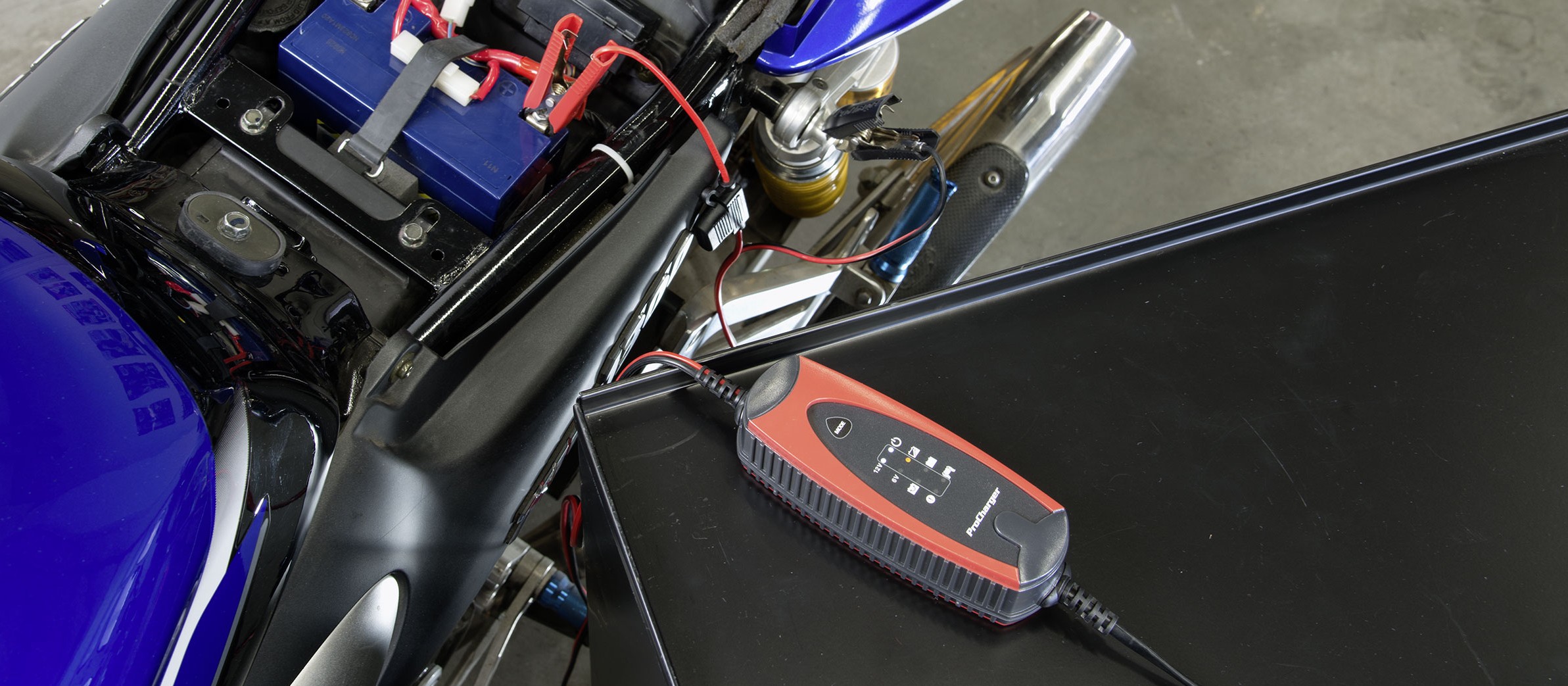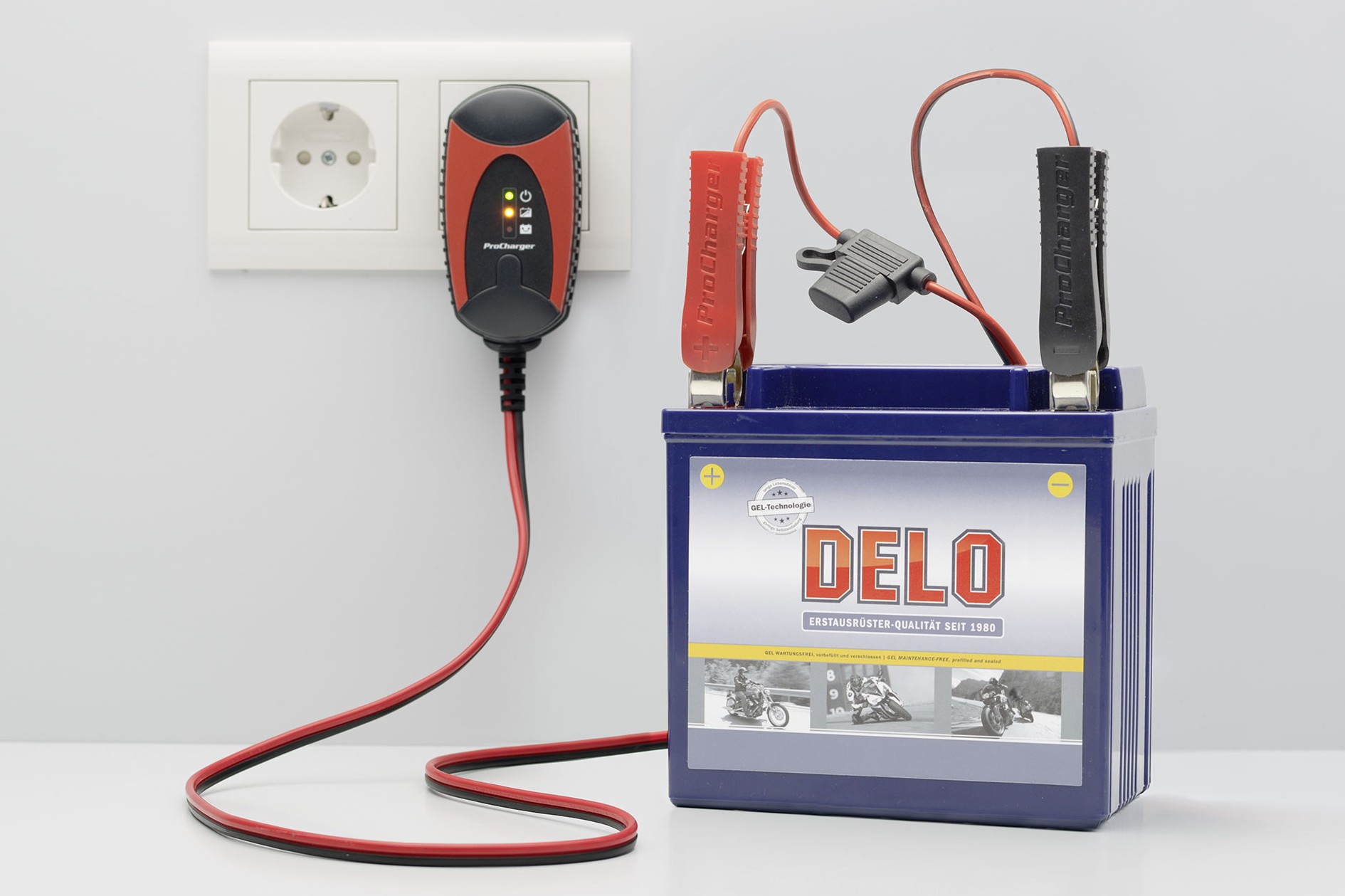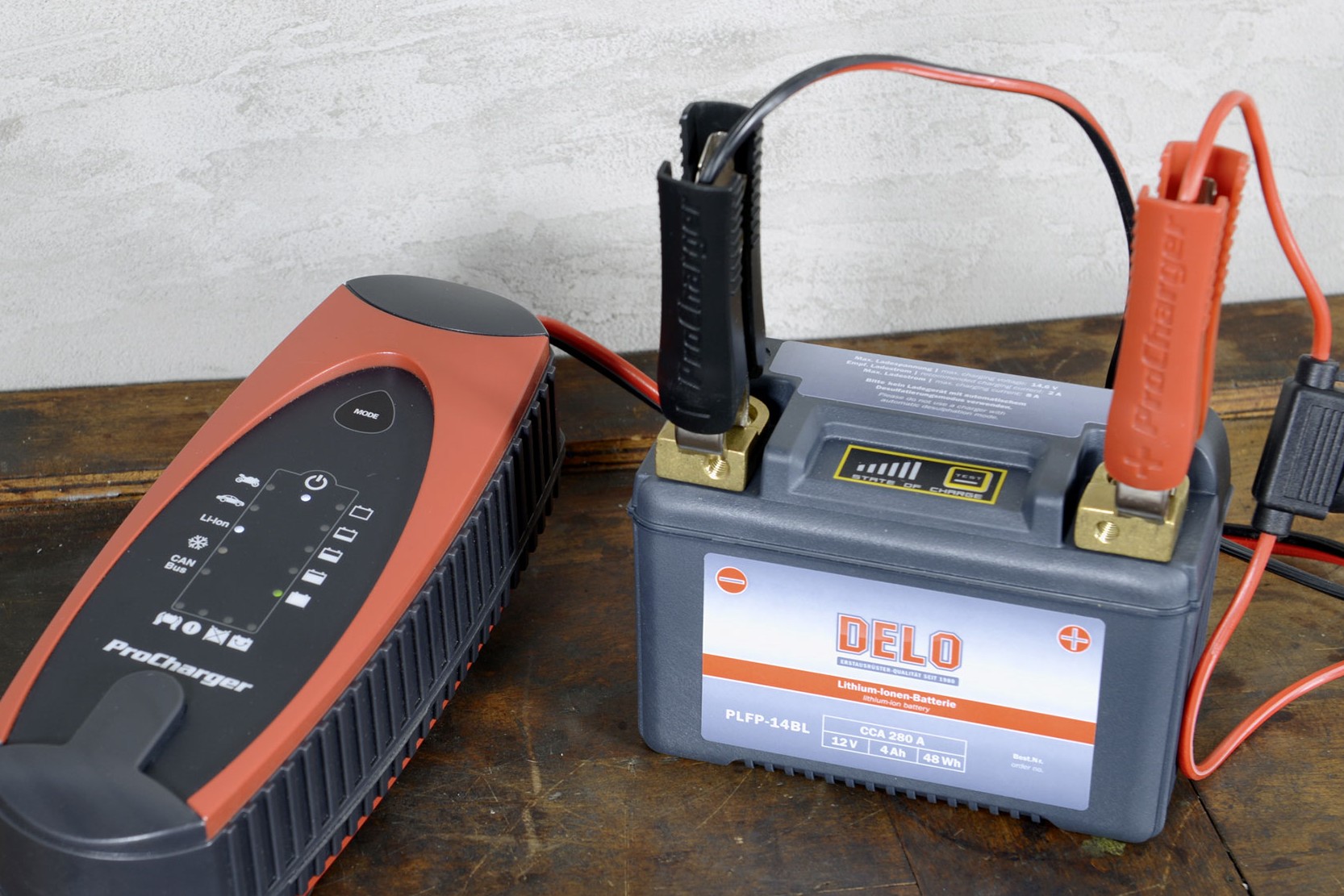Charging a motorcycle battery
When your battery starts to struggle, a charger is the biker's best friend. To keep it that way, we have a few tips for you.

How to charge a battery correctly
When your battery is not used for a long period, e.g. over the winter months, it still needs to be charged, even if no electrical devices are connected and you remove it from your motorcycle. Batteries have internal resistance, which means that they gradually self-discharge. After one to three months, the battery will be flat. And if you think you can simply charge it back up, you're in for an unwelcome surprise because a deeply discharged battery can no longer store energy properly, and can only accept charge to a limited degree. To help you avoid ever being in this situation, we've put together some tips on timely and correct charging and the right battery charger to use.
Types of charger
Nowadays there are various types of battery for motorcycles and scooters, and consequently there are a range of chargers to choose from. Over the years, the following types of charger from different manufacturers have come onto the market:

Fig.1: Simple automatic charger for winter storage: ProCharger 600
Standard chargers
Conventional chargers without either automatic switch off or regulated charging current have become something of a rarity. They can only be used for charging standard acid batteries, with which you can estimate the progress of charging by observing the liquid. When the liquid starts to give off gases and more and more bubbles rise up, you disconnect the charger and assume that the battery is fully charged.
Sealed AGM, gel, pure lead and lithium-ion batteries must never be connected to this type of charger, as there is no reliable way of knowing when the battery is fully charged. Overcharging always damages the battery and shortens its life, in fact quite considerably if it is repeatedly overcharged.
Simple automatic chargers
Simple automatic chargers do at least switch themselves off when the battery is fully charged. But what they can't do is adapt the charging voltage according to the battery's state of charge. As a rule, they are not capable of recovering a deeply discharged gel, pure lead or AGM battery. For less demanding tasks, on the other hand, e.g. trickle charging your battery over the winter, they're excellent.

Fig. 2: Modern all-round charger with desulphation function: ProCharger 1,000
Microprocessor-controlled automatic charger
An "intelligent" microprocessor-controlled automatic charger offers major advantages, not just for modern AGM, gel and pure lead batteries, but also for conventional acid batteries. This is because these chargers have diagnostic and maintenance functions, which make it possible to significantly extend the battery's life.
They are able to detect the battery's state of charge and adapt the charging current accordingly. In desulphation mode, they can revive many an ageing, partially sulphated battery sufficiently for it to deliver the cranking power required by the motorcycle's starter motor. In addition, with their maintenance/trickle charging function, they can protect the battery against sulphation while your motorcycle is laid up. In maintenance mode, small current pulses are sent into the battery at set intervals to prevent sulphate from building up on the lead plates. You can find out more about sulphation and batteries in the DIY tip Battery.

Fig. 3: Charging at an OEM vehicle socket requires a CAN bus enabled charger. Here: ProCharger 4,000
Microprocessor-controlled charger with CAN bus compatibility
If you have a motorcycle with CAN bus electronics and you want to charge the battery via a standard, built-in charging socket, you would need to use a special, microprocessor-controlled charger that is CAN bus compatible. Most other chargers would not work from the OEM vehicle socket (depending on the CAN bus software) because when the ignition is switched off, the socket is also disconnected from the electrical system. If the battery is reasonably accessible, you can, of course, connect the charging cables direct to the battery terminals. A CAN bus compatible charger sends a signal to the motorcycle's computer via the socket to enable the socket for charging.

Fig. 4: Lithium-ion batteries need a special charger
Charger with lithium-ion charging mode
Likewise, if your motorcycle has a lithium-ion battery, you should get yourself a special charger with a lithium-ion charging mode. Lithium-ion batteries may be damaged if the charging voltage is too high, so never use a charger that delivers a very high starting voltage to the battery (desulphation function). High charging voltages above 14.6 V and fluctuating pulse charging programs may damage a lithium-ion-battery! This type of battery requires a constant charging current.

Fig.5: Monitor and charging socket in one: ProCharger Comfort Indicator
The correct charging current
In addition to using the right type of charger, the power rating is also critical. The charging current delivered by the charger should not exceed 1/10 of the battery capacity. Example: If your scooter has a 6 Ah battery, you should not use a charger that supplies a charging current any higher than 0.6 A, as the small battery would be damaged and its life shortened.
Conversely, a small charger designed for motorcycle batteries would take a long time to charge a large car battery – possibly even several days. When you buy a charger, always check its rating, given in amps (A) or milliamps (mA).
If you need to charge both car and motorcycle or scooter batteries, a charger that allows you to select different charging currents is ideal. The ProCharger 4.000, for example, can be switched from 1 A to 4 A, which means that most car batteries can be charged within a day, even if they're completely flat.
If it's only for maintenance or trickle charging, you can safely use a small, microprocessor-controlled charger, which will keeps your battery in good condition as long as the vehicle is stationary.
Good to know
Practical tips
- Chargers for car and motorcycle batteries are not recommended for recharging nickel-cadmium batteries or the batteries used in model cars etc, or wheelchair batteries. These specific types of rechargeable battery require special chargers with an adapted charging cycle.
- If you leave the battery in your motorcycle and charge it via a vehicle socket that is directly connected to the battery, always remember to switch off/disconnect any hidden loads, like a clock or anti-theft alarm. If a hidden load somewhere (or a leakage current) is active, the charger will not be able to switch to maintenance/trickle mode, and consequently the battery will be overcharged.
- Only sealed batteries (gel, AGM, pure lead, li-ion) should be charged while installed in the motorcycle. Standard acid batteries must always be taken off the motorcycle and the cell caps removed so that the vapours can escape. These vapours are corrosive and could damage your paintwork.
- Whether or not you leave your battery permanently connected to a maintenance charger while your bike is laid up so as to protect it against sulphation depends on the type of battery. Conventional acid batteries and AGM batteries that are not ready filled (not factory activated) benefit from permanent maintenance charging. Pure lead and gel batteries and also sealed AGM batteries have such low self-discharge nowadays that it's sufficient to top them up with the charger once every 4 weeks. For this reason, the BMW CAN bus electronics, for example, shut down the vehicle's charging socket when it recognises that the battery is fully charged, so maintenance charging is not possible anyway. Lithium-ion batteries do not require any maintenance charge because they have virtually zero self-discharge. Their state of charge is usually shown by an LED indicator on the battery. As long as this type of battery is still 2/3 full, it doesn't need to be recharged.
- If there is no available power socket to plug a charger into, you can use a mobile charger like the Fritec Charging Box. This device essentially contains a powerful rechargeable battery, which is itself capable of charging a motorcycle battery. There are also jump starters that do more than just deliver an instantaneous boost. With appropriate adapter cables they can also recharge a motorcycle battery enough for the motorcycle to be able to restart under its own steam.
- Continuous monitoring: The ProCharger Comfort Indicator tells you the state of your battery at the press of a button. A very handy feature: If the LED is yellow, or even red, you can simply connect your ProCharger battery charger to the Comfort Indicator – a real advantage if the battery itself is difficult to get at.
The Louis Technical Centre
If you have a technical question about your motorbike, please contact our Technical Centre, where they have endless experience, reference books and contacts.
Please note!
These tips for DIY mechanics contain general recommendations that may not apply to all vehicles or all individual components. As local conditions may vary considerably, we are unable to guarantee the correctness of information in these tips for DIY mechanics.
Thank you for your understanding.



